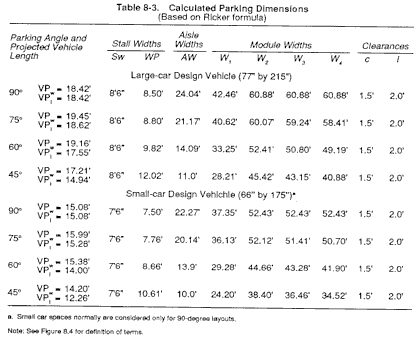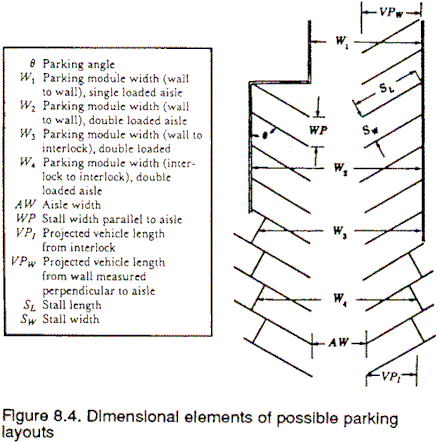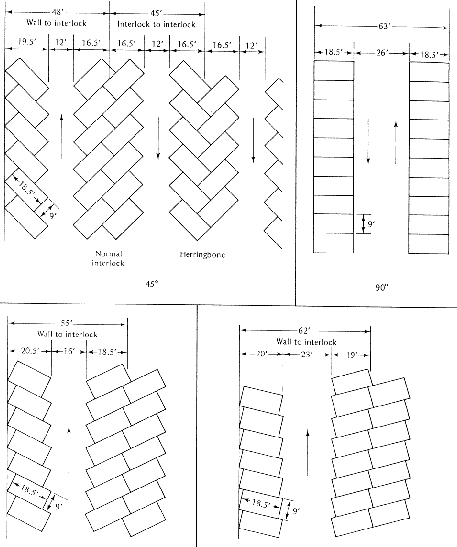
Parking Stall Layout Considerations
The objective of the layout design is to maximize the number of stalls, while following
the guidelines below.
- The layout of the parking facility must be flexible enough to adapt to future changes in
vehicle dimensions.
- The stall and aisle dimensions must be compatible with the type of operation planned for
the facility.
The critical dimensions are the width and length of stalls, the width of aisles, the
angle of parking, and the radius of turns. All of these dimensions are related to the
vehicle dimensions and performance characteristics. In recent years there have been a
number of changes in vehicle dimensions. The popularity of minivans and sport utility
vehicles has had an impact on the design of parking facilities. For the near future, a
wide mix of vehicle sizes should be anticipated. There are three approaches for handling
the layout:
- Design all spaces for large-size vehicles (about 6 feet wide and 17-18 ft long).
- Design some of the spaces for large vehicles and some for small vehicles (these are
about 5 ft wide and 14-15 ft long).
- Provide a layout with intermediate dimensions (too small for large vehicles and too big
for small vehicles).
For design, it is customary to work with stalls and aisles in combinations called
"modules". A complete module is one access aisle servicing a row of parking on
each side of the aisle. The width of an aisle is usually 12 to 26 feet depending on the
angle at which the parking stalls are oriented.
Stall Width
For simplicity, the stall width is measured perpendicular to the vehicle, not
parallel to the aisle. If the stall is placed at an angle of less than 90o,
then the width parallel to the aisle will increase while the width perpendicular to the
vehicle will remain the same.
Stall Length
The length of the stall should be large enough to accommodate most of the vehicles. The
length of the stall refers to the longitudinal dimension of the stall. When the
stall is rotated an angle of less than 90o, the stall depth perpendicular to
the aisle increases up to 1 foot or more. It should be noted that the effective
stall depth depends on the boundary conditions of the module, which could include walls on
each side of the module, curbs with or without overhang, or drive-in versus back-in
operations. For parking at angles of less than 90o, front bumper overhangs
beyond the curbing are generally reduced with decreasing angle and, for example, drop to
about 2 feet at 45o angles. The Table 8-3 below gives the standard dimensions
for several different layouts as defined by Figure 8-4.


Table 8-3 and Figure 8-4 where taken from:
Weant, R.A. and Levinson, H.S., Parking, Eno Foundation, 1990, page 161.
Interlock Module
A special type of module, the interlock, is possible at angles below 90o.
There are two types of interlock. The most common, and preferable, type is the
bumper-to-bumper arrangement. The second type, the "herringbone" interlock, can
be used at 45o and is produced by adjacent sides having one way movements in
the same direction. This arrangement requires the bumper of one car to face the fender of
another car. Figure 8-3 shows several different module layouts that are commonly used.

Comparing Angle Efficiencies
The relative efficiencies of various parking angles can be compared by looking at the
number of square feet required per car space (including the prorated area of the access
aisle and entrances). Where the size and shape of the tract is appropriate, both the 90o
and the 60o parking layouts tend to require the smallest area per car space. In
typical lot layouts for large size vehicles, the average overall area required (including
cross aisles and entrances) ranges between 310 and 330 square feet/car. A very flat angle
layout is significantly less efficient than other angles.
One-Way Aisles
There are many conditions where one-way aisles are desirable. With parking angles less
than 90o, drivers can be restricted to certain directions. However, the angle
should usually be no greater than 75o. Drivers may be tempted to enter the
parking aisles and stalls from the wrong direction when the stall angle is too large.
Adjacent aisles generally have opposite driving directions.
|